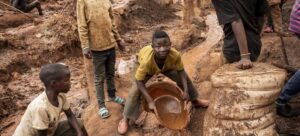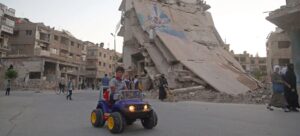The Conference’s third day, spotlighting the state of the global fishing industry and the sustainability of aquaculture, featured the launch of the UN Food and Agriculture Organization’s (FAO) State of World Fisheries and Aquaculture flagship report.
Growing demand for fish and other aquatic foods is rapidly changing the whole sector, with consumption expected to increase, driven mostly by a fast-paced increase in population, changes in post-harvest practices and distribution, as well as in dietary trends focusing on better health and nutrition.
Is sustainability at sea realistic?
According to FAO, created in 1945 to alleviate hunger, the current demand, and the approach to meeting the needs of 10 billion people as population grows, are pressuring food systems, at the same time that climate change, COVID-19, environmental degradation, and conflict are putting them to test.
The State of World Fisheries and Aquaculture (SOFIA) flagship report analyses the status of global stocks as well as trends in fisheries, and aquaculture, including at the regional level.
Concentrating on ‘Blue Transformation’, a visionary strategy designed to enhance the potential of food systems under water and feeding the world’s growing population sustainably, SOFIA works as a critical reference for governments, policymakers, academics and others in the sector.
A ‘Blue Transformation’ in how we can produce, manage, trade, and consume aquatic foods, in order to achieve the UN Sustainable Development Goals or SDGs, said FAO.
As the sector continues to expand, FAO says more targeted transformative changes are needed to achieve a more sustainable, inclusive, and equitable fisheries and aquaculture sector, and combat the growing threat of food insecurity.
Speaking to the press, Manuel Barange, Director of FAO’s Fisheries and Aquaculture division, highlighted that this was the first time that such a key report has been launched outside FAO Headquarters in Rome.
Record high
According to FAO, growth of aquaculture, particularly in Asia, lifted total production in the sector to an all-time high of 214 million tonnes in 2020, consisting of 178 million tonnes of aquatic produce and 36 million tonnes of algae for consumption.
Production in 2020 was 30 percent higher than the average in the 2000s and more than 60 percent above the 1990s average.
“There is a real concern over the price of fish, price of food in general, but price of fish in particular which has grown 25 per cent from December last year, to April this year. [That] puts pressure on the consumer”, Mr. Barange told journalists.
Food insecurity
With more than 800 million people now suffering hunger and 2.4 billion people with severely limited access to adequate food, the challenge of feeding a growing population without exhausting current resources, continues to increase.
In this context, aquatic food systems are increasingly in the spotlight, due to their huge potential to meet rising demand.
‘’The growth of fisheries and aquaculture is vital in our efforts to end global hunger and malnutrition, but further transformation is needed in the sector to address the challenges,’’ says FAO Director General, QU Dongyu.
‘’We must transform agrifood systems to ensure aquatic foods are sustainably harvested, livelihoods are safeguarded, and aquatic habitats and biodiversity are protected”, he added.
Nutrition
Significant growth in aquaculture has driven global fisheries and aquaculture production to a record high as aquatic foods make an increasingly critical contribution to food security and nutrition in the 21st century.
Speaking at the SDG Media Zone at the Conference in Lisbon, UN Secretary-General’s Special Envoy for the Ocean, Peter Thomson, called aquaculture the “healthiest nutrition for the world”, that holds the “potential to feed our grandchildren and other generations to come, if we do it right”.

© FAO/John Wessels
Senegalese fisherman offload fish from their boats to sell in local markets and export to other countries.
Aquaculture as a solution
In 2020, animal aquaculture production reached 87.5 million tonnes, six percent higher than in 2018. On the other hand, the volume of catch from open seas, dropped to 90.3 million tonnes, a fall of four percent compared with the average over the previous three years.
Growing demand is rapidly changing the fisheries and aquaculture sector. Consumption is expected to increase by 15 percent to supply on average 21.4 kg per capita in 2030, driven mostly by rising incomes and urbanization, changes in post-harvest practices and distribution, as well as in dietary trends focusing on better health and nutrition.
With total production of aquatic foods expected to reach 202 million tonnes in 2030, mainly due to the continuing growth of aquaculture, the figure is expected to reach 100 million tonnes for the first time in 2027, and 106 million tonnes in 2030.
“We need to make sure that we start looking at the species that are arriving to markets that might be different from the historical ones”, said Mr. Barange, adding that if the adaptation to climate change is done properly, aquatic food consumption per capita would continue to grow, helping release pressure on land-based food production systems.
People in fishing communities
“Over 58 million people depend directly on fisheries and aquaculture: fisherman, fisherwoman and aqua-culturists”, FAO expert Mr. Barange stressed.
Fisheries and aquaculture contribute to employment, trade, and economic development.
According to the latest data, an estimated 58.5 million people were employed in the sector, and of these, only 21 percent are women.

© ADB/Eric Sales
Neighbors help each other pull a fishing net in Gentuma Raya, Indonesia.
Around 600 million people are estimated to depend on fisheries and aquaculture in some way for their lives and livelihoods. With those numbers, the need to build resilience is obviously critical for equitable and sustainable development.
Margaret Nakato, coordinator at the Katosi Women Development Trust (KWDT) in Uganda, also taking part at the Conference, works with fisherman and fisherwoman on the ground.
“One of the problems is that the current regimes of conservation are contributing to displacing and destructing the fishing communities from their territories”, the Conference heard.
She called on Member-States to involve small fishing communities, saying that “any sustainability agenda has to take them into consideration, as well as the social, cultural and economic components of the fishing communities, to ensure that our measures are effective but also we can share the equitable benefits from the resources”.
The need for transformation
FAO says more needs to be done to feed the world’s growing population while enhancing the sustainability of stocks and fragile ecosystems and protecting lives and livelihoods in the long-term.
The sustainability of marine fishery resources remains of significant concern, according to the FAO report, with the percentage of sustainably fished stocks falling to 64.6 percent in 2019, a 1.2 percent decline from 2017.

© FAO/Sylvain Cherkaoui
The fishing port of Joal in Senegal.
However, there are encouraging signs as sustainably fished stocks provided 82.5 percent of the total volume of 2019 landings – a 3.8 percent increase since 2017. This seems to indicate that larger stocks are being managed more effectively.
Before leaving the stage, UN Secretary-General’s Special Envoy Peter Thomson called for more financing for SDG14, suggesting that financing should be put in alternatives.
“I think things are changing”, he said, stressing the need to finance the solutions that are being developed. “Action is about money, put the hand in the pocket and make it happen”, Mr. Thomson concluded.
Until Friday, UN News will bring you daily coverage on the Conference as well as interviews, podcasts, and features, which you can access here.

















